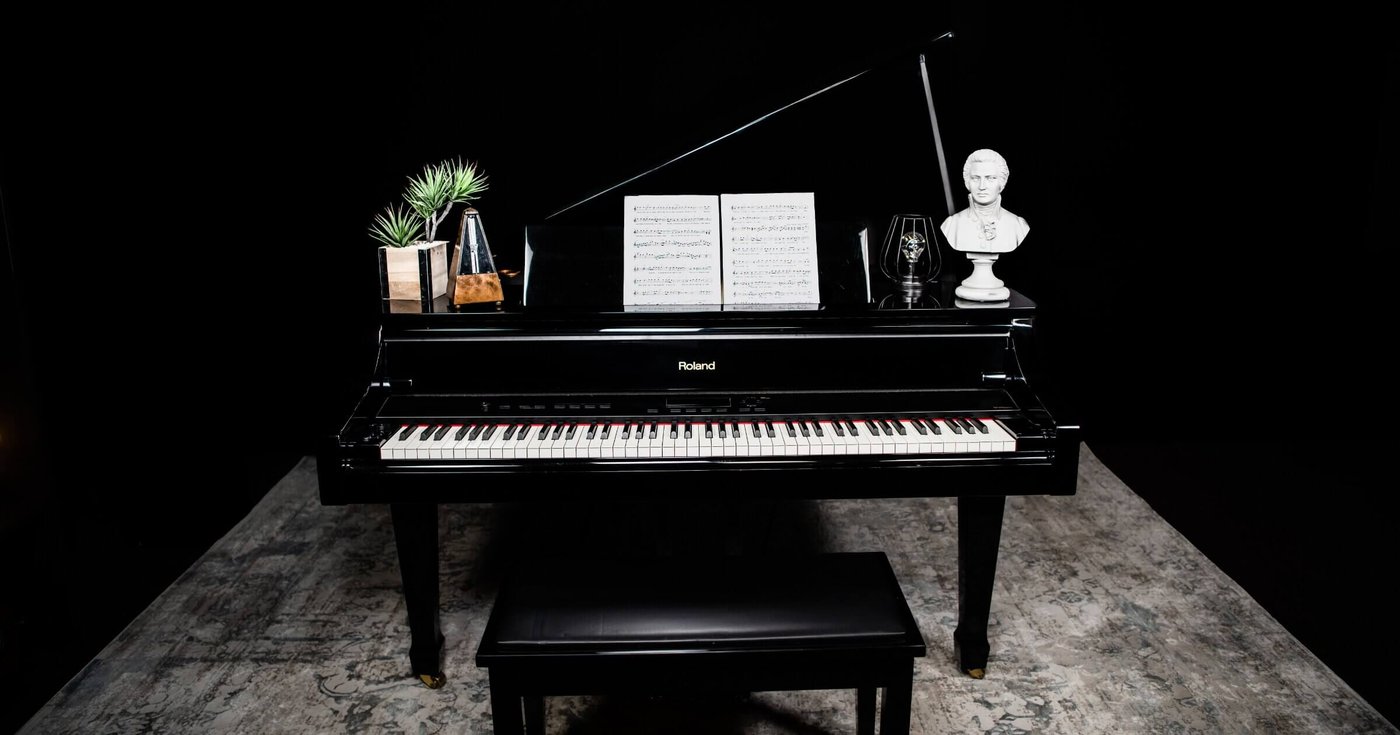
We often think of classical music as complex and difficult, but there are plenty of beautiful, easy classical piano pieces in this genre.
When we say “classical” today, we tend to mean music that uses instruments you’d find in an orchestra. But technically, the Classical Period of music refers to a narrower era of time, roughly 1750 to 1820. Simplicity, elegance, and sparseness were trendy during this period. So, no, not all classical music is complex—in fact, Classical pieces are often intentionally simple!
Classical music is also more similar to pop music than you may think. And learning classical pieces will help you develop sight-reading, theory knowledge, and hand independence. After all, many beginner piano classical pieces were composed with students in mind. Here are a few to get you started.
Table of Contents:
Get four free lessons designed for beginners taught by Victoria Theodore, a classically trained pianist with degrees from Oberlin College and Stanford University, who has played with Beyoncé and Stevie Wonder.
Composer: Unknown, possibly Leopold Mozart
Sheet Music: Free Download
Why Learn It: Nannerl was the nickname given to Maria Anna Mozart, Wolfgang Amadeus Mozart’s older sister and an accomplished pianist in her own right. The Minuet in F comes from a collection of pieces by a variety of composers called Nannerl’s Notebook. It was compiled for his children by Nannerl’s and Wolfgang’s father Leopold, so it’s designed for beginner piano players.
The Minuet in F Major is short yet delightful, and if you get your hands on the entire Notebook, you’ll find plenty of beginner-friendly pieces to toy with. All in the elegant, minimalistic style of the Classical Period.
Composer: Christian Pezold, but often attributed to Johann Sebastian Bach
Sheet Music: Minuet in G Major; Minuet in G Minor
More Tips
Why Learn It: The Minuet in G Major is often associated with kids learning the piano. But as you can see in the video, even piano masters like Lang Lang can have fun with making this simple minuet interesting and expressive.
The Minuet in G Major only uses one sharp, so there are few black keys to worry about. This song is perfect for folks learning how to cross over and tuck under while playing scales. It’ll also familiarize you with changing hand positions all over the keyboard.
Composer: Johann Sebastian Bach
Sheet Music: Free Download
More Tips
Why Learn It: The density of notes in the sheet music for Prelude in C Major may seem daunting, but it’s actually a very accessible piece that appears on many “easy classical piano song” lists. This piece is essentially an exercise in broken C major chords. Supplement your practice with our lessons on piano chords, and you can learn a lot! See if you can identify Bach’s chords and chord progressions.
The way this piece is written is quite predictable, so you can easily look ahead and prepare yourself for the next chord. Once you master it, the Prelude can be an ideal warm-up or prelude (see what I did there?) to your practice sessions.
Composer: Johann Friedrich Franz Bürgmuller
Sheet Music: Free Download
Why Learn It: “La Candeur” is the first étude in Bürgmuller’s collection 25 études faciles et progressives. An étude (French for “study”) is a short piece designed around essential techniques like scales, chords, jumps, and so forth. Études are helpful because, while practicing technique like scales and arpeggios is important, many pianists find them boring. So, études are a way to develop technique without yawning at the keyboard.
Bürgmuller’s collection was a favorite from my childhood, but don’t worry—these pieces aren’t childish at all! Many can stand alone in their own right as beautiful pieces.
Composer: Muzio Clementi
Sheet Music: Free Download
More Tips
Why Learn It: Clementi wrote a number of beginner-friendly sonatinas that are a joy to play—they’re very accessible yet sound grand at the same time. With three movements and some modulations into different keys, the Sonatina No.1 sounds at home in a concert hall. Once you master this sonatina, check out Clementi’s other sonatas and sonatinas, many of which are in C, G, and F major with minimal sharps and flats.
Composer: CPE (Carl Philipp Emanuel) Bach, one of Johann Sebastian Bach’s sons
Sheet Music: Free Download
Why Learn It: CPE Bach’s Solfegietto sounds really cool. So cool, people have made covers of it on the electric guitar. While it sounds very impressive and fancy, your hands take turns most of the time, so hand independence is less of a challenge. See how fast you can play this! The dark, minor key further gives this piece an epic, dramatic mood reminiscent of speed metal.
Composer: Frédéric Chopin
Sheet Music: Free Download – Original and Simplified
Tutorial
Why Learn It: The Waltz in A Minor is one of Chopin’s more accessible pieces. Set in A minor (no sharps or flats—yay), this waltz is stately and elegant. It’s simple, but it doesn’t sound beginner-like at all. There’s even an impressive triplet and quintuplet run which, once you break it down, is just a simple triad arpeggio.
We have the sheet music (original and simplified) available free for download AND expert practice tips here.
Composer: Johann Pachelbel
Sheet Music: Simplified arrangement; other arrangements
Tutorial With Summer Swee-Singh
Why Learn It: Not only is Canon in D immensely popular, it’s made a huge impact on the history of music. It’s a mainstay at weddings, and the chord progression of this song has made its way into our collective music consciousness. You can hear it in songs like “Basketcase” by Green Day and “Don’t Look Back in Anger” by Oasis.
Composer: Erik Satie
Sheet Music: Simplified arrangement; original
Why Learn It: You’ve probably heard it in movies. Satie’s Gymnopédie No. 1 is minimalistic and abstract, yet strangely beautiful at the same time. This piece is a vibe of its own.
While the piece is slow and steady, the original sheet music can be quite challenging to beginners because the left hand does some pretty wide leaps. You’re essentially playing very slow stride piano! So, we’ve included a link to our simplified arrangement to get you started. Use that as your stepping stone.
Classical music has a reputation for being stuffy and serious, but it’s a very diverse genre. If you do enough digging, you’re likely to find something you like. Classical music also informs the jazz, blues, and pop genres. It’s all connected, and it’s all very fun to play.
One convenient thing about playing classical pieces is, thanks to copyright expiration, you can access the majority of classical sheet music for free. The International Music Score Library Project (IMSLP) has a vast, online database of free classical sheet music.
Want more classical content? Check out these lessons:
Get exclusive interviews, fascinating articles, and inspiring lessons delivered straight to your inbox. Unsubscribe at any time.
Charmaine Li is a Vancouver writer who has played piano for over 20 years. She holds an Associate diploma (ARCT) from the Royal Conservatory of Music and loves writing about the ways in which music—and music learning—affects the human experience. Charmaine manages The Note. Learn more about Charmaine here.


By signing up you’ll also receive our ongoing free lessons and special offers. Don’t worry, we value your privacy and you can unsubscribe at any time.
We use cookies for traffic data and advertising. Cookie Policy »